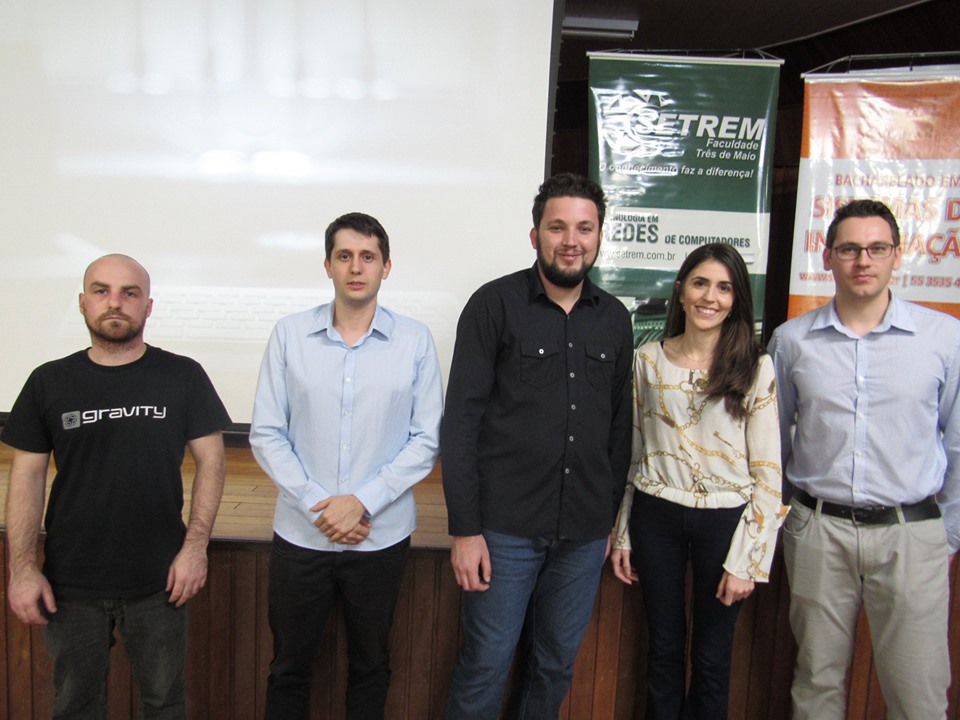On June 17, 2019, at Três de Maio Faculty – SETREM, the members of LARCC Djalma, Claudio and Larissa presented their work to complete the undergraduate course. Djalma is a student from the Computer Networking course while Claudio and Larissa are from the Bachelor’s Degree in Information Systems.
The work developed by the academics Claudio Scheer and Larissa Guder aimed to carry out a systematic literature review for the use of deep learning in agriculture. This machine learning is done using neural network models, which resemble the human brain. The theme of agriculture was purposely chosen because it is very important in the northwest region of the state of Rio Grande do Sul. Through this research, other researchers may have a summarized view of the deep learning solutions already presented for various areas in agriculture. Moreover, the work pointed out that still are research to be developed in Brazil and in the world.
The research developed by the academic Djalma aimed at creating a conceptual model for monitoring and managing smart datacenters. Datacenters are large-scale computing infrastructures that serve today’s top companies, which have their software and computer services installed. This research contributed to the process of automation and organization of the requirements to implement smarter management and monitoring in this type of infrastructure. From the model created, a smart Temperature Management was deployed to prevent overheating, as well as the management of the energy consumption of the servers have been implemented to work with limited energy available in the data center of the Advanced Research Laboratory on Cloud Computing (LARCC).
The titles and abstracts of each work are shown below.
Authors: Claudio Scheer, Larissa Guder
Advisor: Prof. Dr. Dalvan Griebler
Title: Deep Learning in Agriculture: A Systematic Literature Review
With the growth of computational power, deep learning algorithms have achieved remarkable results in several areas. Agriculture is one of the areas that are using these algorithms for the most varied domains. Therefore, this work presents a systematic literature review to consolidate the state-of-the-art about the use of deep learning applied to agricultural challenges. Papers published between January 2012 and April 2019 were considered. From the 819 papers found, 230 papers were classified. We evaluated the deep learning techniques used, crops covered, data sets used, deep learning and agriculture challenges, and among other important insights. The results have shown that deep learning is successfully used for several crops in agriculture. In the livestock branch, for example, most of the works achieved an accuracy above 95%. In total, 47.2% of the papers achieved an accuracy above 95%. Consequently, there is a lot of work to be done in the area of deep learning for agriculture. Our analysis are very important to support new research that seeks to apply deep learning in agriculture and highlight the research gaps.
Author: Djalma Teixeira
Advisor: Prof. Dr. Dalvan Griebler
Co-advisor: Prof. MSc. Adriano Vogel
Title: Modelo Conceitual de Monitoramento e Gerenciamento para Smart DataCenters
The demand for smart datacenters has been increasing considerably due to the complexity of managing the current infrastructures, which is due to the increasing need for computing resources within organizations. The present work aims to propose a model of intelligent management and monitoring for datacenters and to test its effectiveness through the partial implementation of the same. A complete survey of the physical infrastructure, logical network, and services in the LARCC IT infrastructure was carried out. By means of the results obtained, the classification of the datacenter of the laboratory was made according to the requirements of ANSI TIA 942. Through the analysis and research carried out by related works, a conceptual model for monitoring and management was elaborated intelligent for computer infrastructures, which was divided into five major areas: air conditioning, energy, computing, network, and security. We also defined the events that affect these elements, how to monitor them and how to manage them based on the autonomous computing approach. With this, the models were implemented regarding temperature and energy, which uses reactive actions to address and contain consequences of overheating and energy loss. To implement this flow of actions was used the tool Zabbix, and its function of executing remote commands for practical application of the model. It is concluded that the proposed conceptual model is more effective in the containment of critical events that may affect the infrastructure, these results were tested and validated in practice for the elements of temperature and energy.
From the left to the right hand side: Fernando Pinheiro (referee), Adriano Vogel (co-advisor), Djalma Teixeira (student), Priscila Guarienti (referee), Dalvan Griebler (advisor)

From the left to the right hand side: Priscila Guarienti (referee), Larissa Guder (student), Claudio Scheer (student), Samuel de Souza (referee) Dalvan Griebler (advisor), Adriano Vogel (referee), Tiago Seibel (referee)



